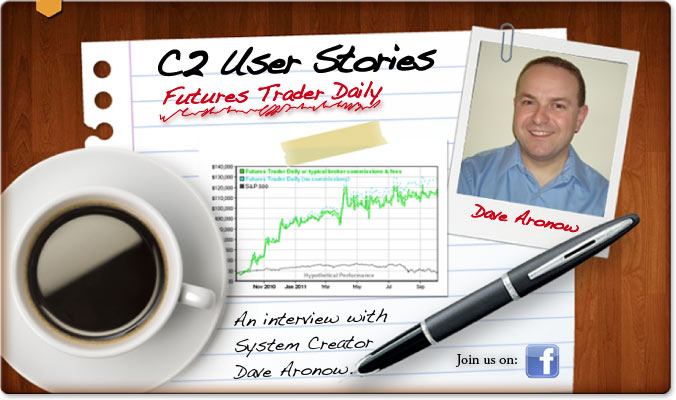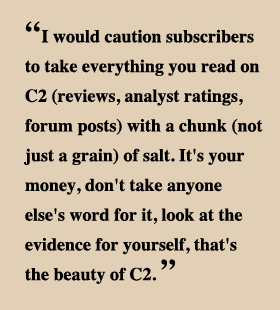|
Futures Trader Daily

Instruments:
Futures
System Started:
9/8/2010
Strategies:
Market timing
Avg. Trade Duration:
4.9 Days
Overview:
Futures Trader Daily seeks to capture short term moves in futures over a period of 2-7 days. Trades are entered every night for the following session.
Read more...
Real Reviews:

I've been with FTD for a few months and happy with it.
The market the last couple months has been tough and FTD is holding well.
The result has been good the last couple weeks. If the system gives me 50% year in and year out,
I will be very happy but I think this system has more potential than that. I tried to keep my
expectation reasonable and not expecting the system to win in all markets for every trade.
I think this system is well diversified and will perform well long term. Time will tell and
I intend to stay long enough to see it. The developer has been terrific and forthright,
warning subscribers that the worst draw down is the one that has not happened yet and be ready
when it comes. He has listened to constructive criticism and incorporate it when possible.
- from C2 Autotrader
See All Reviews
|
|
Interview with David Aranow,
Trading System Developer
interviewed by David Sinton
DS: How did you develop Futures Trader Daily?
David Aronow: I began working on automated trading systems after
coming to the conclusion I was not cut out for discretionary trading. I read all the books I could on system development, including those by Thomas Stridsman,
Perry Kaufman, as well as others.
Futures Trader Daily was a combination of several concepts
in those books. I began trading it in late 2007. In 2010, some ideas I had for
additional filters panned out well, and it took on its current form.
DS: How did you find C2?
David Aronow: I came upon C2 several years ago due to a link from the
Wealth-Lab website. At the time, I was looking at C2 from a subscriber perspective, and it was very
interesting, but at the time I don't think it supported automated trading, at least not Gen3.
It has come quite a long way in a few years.
DS: What do you like about C2?
David Aronow: It's very easy to enter the trade signals using
the C2 API. Also, there's a large user base, which means new subscribers can
find my system. And C2 supports a lot of different futures contracts, including almost all of the futures I trade with my system.
DS: What are some of the challenges of using C2?
David Aronow: In the first few months of my system, I was apparently
the first to trade several of the less commonly-traded futures contracts, which led to some
technical headaches, although Matthew [Klein, the founder of the site] was generally pretty quick to fix them. Since then, the main
issues have been price-format problems, which can lead to incorrect fill reports. These are not that common but are very frustrating.
Other than these occasional issues, things went pretty smoothly after the early
growing pains. The only other problem from time to time is that Gen3 does not
offer a way for new subscribers to start autotrading in a brokerage account without opening all the existing positions. This can be tough when
a position already has a large open profit, but will likely give some profit back before being closed.
(continued)
DS: Are you happy with the number of subscribers you have found on C2? Have you made money?
David Aronow: Yes, to both questions. I am very pleased with the number of subscribers, considering the system is just over a year old.
Overall, my trading system can handle around 40 subscribers before it starts to see significant
slippage in the primary contracts. We approached that number in April, but subscriber numbers have come down a bit recently due
to the flatness of the system's equity curve over the past few months.
DS: What advice can you give to a system developer who is new to C2?
David Aronow: First of all, be patient. Build your track record. No one is going to subscribe to a system that is three weeks old. And, what's more, you shouldn't want subscribers right away.
Wait a few months before you start actively to look for them. This will give you a chance to work out any kinks in interacting
with C2, via whatever interface you want to use; and this will give you a chance to focus on your trading without spending too much time interacting with subscribers. Finally, this will give your system a chance to encounter
different types of market environments.
DS: What about advice to subscribers looking for a trading system?
David Aronow: It sounds clichéd, but here's the best advice. If it looks too good to be
true, it probably is. You see it time and time again: people chasing systems (almost always
forex, for some reason) which have a 95% win rate, but an equity curve that displays those telltale warning signs of a Martingale Strategy - those quick downward spikes
followed by those sudden upward recoveries. [Editor's note: Martingale Strategies are trading strategies where the "bet" is increased each time the bet is lost.] Martingale systems inevitably end in disaster. It's sad to watch people get taken in by these systems, again and again,
when the evidence of what happened to other Martingale systems on C2 is available for everyone to see. The way to prevent being fooled by a Martingale strategy is simply this: time. Be patient and watch. These types of systems do not last for more than a few months before they blow up.
At a more general level, avoid
subscribing to any system based on a high winning trade percentage alone. Look at the whole picture. And be patient - a
good lasting system will be there in three months, six months, etc. There's no need to rush right away into
a system making 50% gains . . . and, indeed, pretty much all those systems end the same way. There is no free lunch!
Beyond that, I think subscribers need to perform a true cost/benefit analysis before deciding to subscribe to a system. Instead of comparing two systems based solely on the subscription price,
consider the overall profitability of the system, and your own
tolerance for risk. This is similar to the way a customer should compare
brokers not just merely based on commission cost, but also on quality of fills. Sure, you can save $8 in commissions on
a $100,000 order, but if you end up with a 1-cent-worse fill, you just cost yourself $100.
Finally, I caution subscribers to take everything you read on C2 (reviews, analyst ratings,
forum posts) with a chunk (not just a grain) of salt. It's your money, so don't take anyone else's
word for it. Look at the evidence for yourself. You certainly have a lot of data available for your own study. That's the beauty of C2.
DS: Thanks, Dave.
These results are based on simulated or hypothetical performance results that have certain inherent limitations. Unlike the results shown in an actual performance record, these results do not represent actual trading. Also, because these trades have not actually been executed, these results may have under-or over-compensated for the impact, if any, of certain market factors, such as lack of liquidity. Simulated or hypothetical trading programs in general are also subject to the fact that they are designed with the benefit of hindsight. No representation is being made that any account will or is likely to achieve profits or losses similar to these being shown.
In addition, hypothetical trading does not involve financial risk, and no hypothetical trading record can completely account for the impact of financial risk in actual trading. For example, the ability to withstand losses or to adhere to a particular trading program in spite of trading losses are material points which can also adversely affect actual trading results. There are numerous other factors related to the markets in general or to the implementation of any specific trading program, which cannot be fully accounted for in the preparation of hypothetical performance results and all of which can adversely affect actual trading results.
|
|




